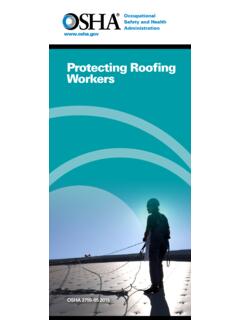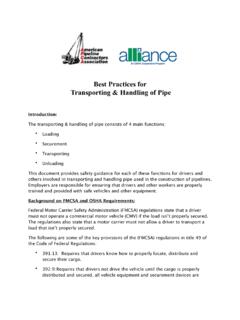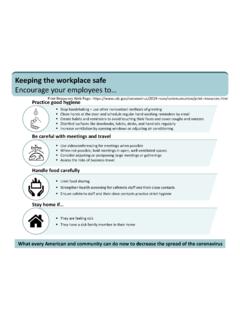Transcription of Circular saw benches - Safe working practices WIS16 - HSE
1 Health and Safety Executive Circular saw benches safe working practices HSE information sheet Information Sheet No 16 (Revision 2). Introduction Braking To reduce the risk of contact with the saw blade during This information sheet is one of a series produced run down, machines should be fitted with a braking by HSE's manufacturing sector. It gives practical device that brings the blade to rest within guidance on safe working practices at Circular saw 10 seconds. Unless already fitted with a manual or foot- benches . operated brake, Circular saw benches with a rundown time greater than 10 seconds should have been fitted When buying a new Circular saw bench, it should be with a braking device by 5 December ,5.
2 Supplied with a declaration of conformity and have a CE Mark. It should be designed and constructed Saw blades to meet BS EN 1870 1:2007 + A1 New saw Dull, badly set and badly ground saw blades produce blades should meet BS EN 847 1 poor quality work. They also increase the effort required for feeding and the risk of accidents from kickback. Deposits of gum or resin near the teeth Accident history tend to cause a saw to stall or the timber to stick. Never try to clean a running blade: stop the saw, Circular saw benches are the machines that cause the remove the blade and use a suitable scraper to most woodworking accidents. Many of these result remove the resin. in the amputation of fingers. Analysis of accidents investigated by HSE has found that most were Saw blade diameter caused by inadequate or missing guards.
3 Many of The diameter of the smallest saw blade that can be these accidents could have been avoided by having a safely used should be marked on the machine. A small correctly adjusted saw guard and using a push-stick. diameter blade (ie less than 60% of the diameter of Inadequate or lack of training for the operator was also the largest blade the saw can accommodate) will have found to be a major cause. It is therefore very important a low peripheral blade speed and will cut inefficiently that only properly trained and authorised operators are and increase the risk of kickback. allowed to use Circular saws. Kickback of the workpiece has caused serious and even fatal accidents. Wood dust Saw benches should be fitted with effective local exhaust ventilation both above and below the table to General safety issues control wood dust6 (see Figure 1).
4 Risk assessment A risk assessment3 should be carried out covering all Workpiece support foreseeable uses and operations at the Circular saw bench. It should identify the action needed to eliminate Adequate workpiece support is essential for all or control risks. As part of the assessment you should operations at a Circular saw bench. Large workpieces consider if there is a more suitable machine for the should be supported using extension tables or roller process or operation. For example, a properly guarded supports at both the infeed and outfeed ends. If there vertical spindle moulder or router are most suitable for is a second operator at the outfeed end to remove grooving work. cut pieces, the table should be extended so the distance between the saw blade spindle and the rear Riving knife and saw guard edge of the table is at least 1200 mm.
5 The second Suitable top guards and riving knives should be fitted operator should always remain at the outfeed end of to all Circular saw benches . It is vital that these are the extension and should not reach forward towards properly adjusted for each job being carried out. the saw. Although the riving knife reduces the risk of Machines should be fully enclosed beneath the table. contact, it cannot prevent it. 1 of 5 pages Health and Safety Executive Exhaust outlet Push stick Extension table Table Riving knife Rip fence Saw guard Exhaust outlet Cross-cut fence Push stick Figure 1 Circular saw Figure 2(b) Low position fence for shallow or angled ripping A rip fence or a cross-cut fence should be used to give adequate workpiece support during cutting (see Use of a push-stick Figure 2(a)).
6 To prevent kickback, the front of the fence must be set no further than the base of the saw blade A push-stick should always be used when making any gullet at table level. When cutting shallow or angled cut less than 300 mm in length or when feeding the work, the normal fence may need to be replaced last 300 mm of a longer cut. Push-sticks should be at with a low fence to aid the use of a push-stick and to least 450 mm long with a bird's mouth' (see Figure prevent the canted saw blade touching the fence (see 3). The leading hand should never be closer than is Figure 2(b)). necessary to the front of the saw and hands should never be in line with the saw blade. Push A push-stick should always be used to remove the cut stick piece from between the saw blade and fence, unless the width of the cut piece exceeds 150 mm.
7 Bird's mouth Figure 3 Push stick Use of power feed Use a demountable power feed whenever practicable to do so. This reduces the risk of contact with the saw Figure 2(a) Normal fence position for ripping blade (see Figure 4). A demountable power feed unit is not a substitute for a riving knife. The riving knife should be kept in position whenever a demountable Timber with a round cross-section should not be cut power feed is used. on a bench saw unless the workpiece is adequately supported and held in position by a gripping device. 2 of 5 pages Health and Safety Executive E. D. Note 1: Distance D measured at table level should not exceed 8 mm. For blades greater than 600 mm diameter, E should be at least 225 mm above the table.
8 Guard removed for clarity Figure 4 Using a demountable power feed Figure 6 Riving knife fixing Ripping and cross-cutting Saw guards should: safe ripping and cross-cutting relies on: be strong and easily adjustable;. be large enough and shaped so as to enclose adequate workpiece support; as much of the blade as is practicable during the correct positioning of the hands; cutting operation;. appropriate use of a push-stick; be kept adjusted as close as possible to the the correct adjustment of the riving knife and saw surface of the workpiece (see Figure 7). guard. Riving knives should: have a chamfered leading edge;. be thicker than the body of the saw blade, but slightly thinner than the width of cut (see Figure 5).
9 A B C Guard Workpiece Note: The saw guard must be adjusted as close to the workpiece as possible Key: A is riving knife thickness Figure 7 Setting of the saw guard B is kerf of saw (width of cut). C is thickness of saw blade body A to be greater than C, but less than B Saw blades should: Figure 5 Thickness of riving knife in relation to the saw be set so that the teeth project through the surface blade of the material during cutting;. not, however, be set higher than necessary;. be rigid and set accurately in line with the saw; be suitable for the work, ie when cross-cutting on shaped so the inner edge follows as closely as a Circular saw bench the ripping blade should be practicable the contours of the largest saw blade replaced with either a cross-cut or combination designed to be used on the machine (see Figure 6).
10 Blade. 3 of 5 pages Health and Safety Executive Rebating and grooving A Circular saw should not be used for cutting a rebate Saw guard with or groove unless the blade is effectively guarded. exhaust outlet This is because the normal saw guard cannot be used. Suitable alternative guards and fixtures are necessary. Figure 8 shows an example of one method Workpiece Fence canted for rebating or grooving using Shaw guards. Where practicable, the tunnel formed by the pressure pads should be designed to meet the requirements of BS. EN ISO 13857 End cleat Figure 9(a) Bevel ripping Fence Workpiece Saddle Fence Figure 8 Saw guard for rebating and grooving on a saw bench Stopped grooving should not be done on a Circular sawing machine.

















